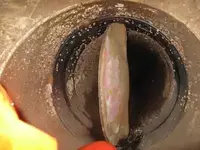Roadhse2
Sr. Member
- Joined
- Mar 15, 2015
- Messages
- 376
- Reaction score
- 366
- Golden Thread
- 0
- Primary Interest:
- All Treasure Hunting
Ok....No crabs
But over a 200+ year timespan you don't think sea life would breach this tunnel at some point and expand in range down it in the normal course of living? That some sign of sea life would be in these shafts, vaults or caverns? What is that 0.00001 eel eating? No signs of any crustaceans at all...worms, barnacles. But here is some info on one my favorite things to eat, that you are familiar with...found in sea caves with no sunlight. These are also not life forms that have adapted to no light over millions of years, like there are 1000 feet and below in the ocean where no sunlight penetrates. There's plenty more, but mainly from Marine Biology papers and simply to long to print portions out here. So yes I would expect some sign of sea life in the OI tunnel, shafts and caverns.
Britannica: Have any cave animals developed a “commuter lifestyle”? In other words, are there animals able to move between open water environments and cave environments?
Iliffe: Along the coastline of the Mediterranean Sea, partially or totally submerged cave entrances lead to more or less extensive networks of submerged tunnels and galleries. Mysids, a type of small, shrimp-like crustacean, spend their days in the dark interior of such caves but move out to the ocean at night to feed, before returning to the sanctuary of the cave at day break. Caves on the sea floor in the Bahamas are called ocean blue holes and have very strong, tidally reversing currents. For six hours, seawater is drawn into these caves with such force that whirlpools form on the surface above them. Then the tide changes and for another six hours, water is expelled so strongly that visible mounds can form on the surface of the sea above them. Only for a brief period at slack tide when the currents decease and change direction, is it possible for divers to enter and explore these systems. Lobsters are found even deep in the interior of many ocean blue holes where they subsist on food sucked into the cave by the current. Animals in such submarine caves are typically not cave adapted, yet some of them over time may evolve necessary adaptations to allow them to make the transition to the much more isolated realm of anchialine caves.
But over a 200+ year timespan you don't think sea life would breach this tunnel at some point and expand in range down it in the normal course of living? That some sign of sea life would be in these shafts, vaults or caverns? What is that 0.00001 eel eating? No signs of any crustaceans at all...worms, barnacles. But here is some info on one my favorite things to eat, that you are familiar with...found in sea caves with no sunlight. These are also not life forms that have adapted to no light over millions of years, like there are 1000 feet and below in the ocean where no sunlight penetrates. There's plenty more, but mainly from Marine Biology papers and simply to long to print portions out here. So yes I would expect some sign of sea life in the OI tunnel, shafts and caverns.
Britannica: Have any cave animals developed a “commuter lifestyle”? In other words, are there animals able to move between open water environments and cave environments?
Iliffe: Along the coastline of the Mediterranean Sea, partially or totally submerged cave entrances lead to more or less extensive networks of submerged tunnels and galleries. Mysids, a type of small, shrimp-like crustacean, spend their days in the dark interior of such caves but move out to the ocean at night to feed, before returning to the sanctuary of the cave at day break. Caves on the sea floor in the Bahamas are called ocean blue holes and have very strong, tidally reversing currents. For six hours, seawater is drawn into these caves with such force that whirlpools form on the surface above them. Then the tide changes and for another six hours, water is expelled so strongly that visible mounds can form on the surface of the sea above them. Only for a brief period at slack tide when the currents decease and change direction, is it possible for divers to enter and explore these systems. Lobsters are found even deep in the interior of many ocean blue holes where they subsist on food sucked into the cave by the current. Animals in such submarine caves are typically not cave adapted, yet some of them over time may evolve necessary adaptations to allow them to make the transition to the much more isolated realm of anchialine caves.





